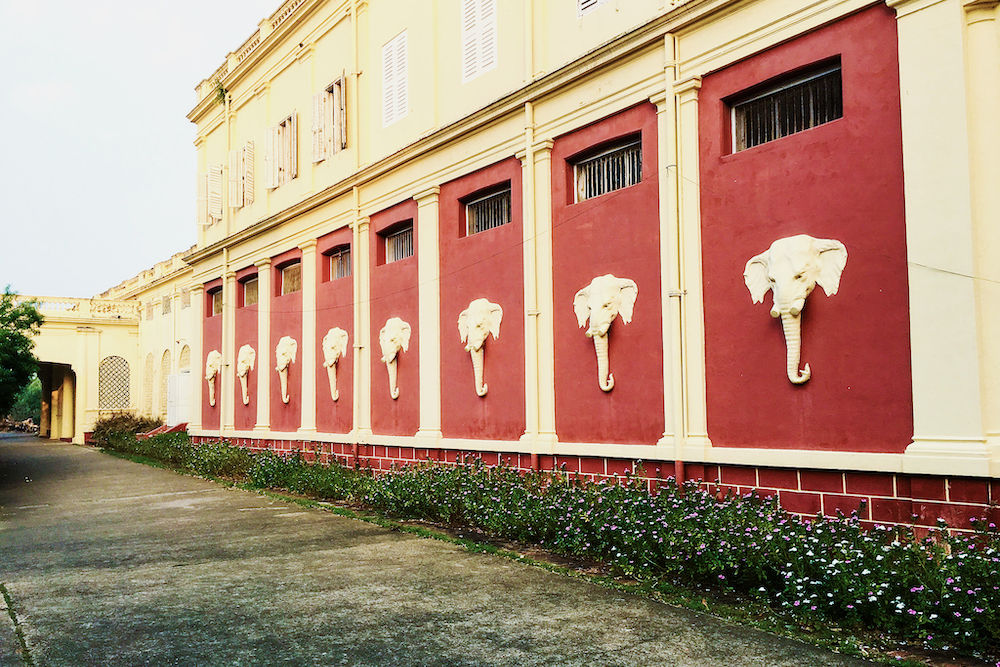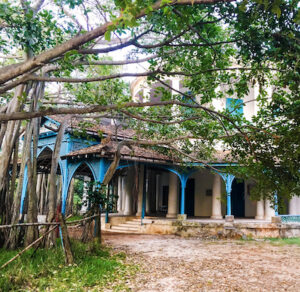
The Theosophical Society’s headquarters in Chennai, India. Courtesy of M. L. Krishnan.
When I turned 14, I made two discoveries.
First, I learned that I would never inherit the smooth drape of my grandmother’s skin. Like my father, I would battle hillocks and mounds of acne pushing up against my face well into adulthood.
Second, and more important, I would come to learn that my home was a forest at the edge of the sea.
In the same year, 1998, I moved into a decrepit bungalow situated within the world headquarters of the Theosophical Society in Chennai, India. The sprawling, 260-acre ecological heritage site sits on the mouth of the Adyar River, where its brackish currents swirl into the Bay of Bengal. Punctuated with neoclassical colonial houses, floating trilithon archways, and cantonment-style hostel dwellings for visitors, the international campus of the Society has largely stood unchanged since its inception.
The Theosophical Society was founded in 1875 by Helena Petrovna Blavatsky, a Russian occultist; William Quan Judge, an Irish American lawyer; and Henry Steel Olcott, an American military officer. With visions in their mouths, they raised paeans to universal brotherhood, comparative religion, and the unexplained edicts of nature.
In their quest for self-actualization, they may have seen the face of utopia in the peninsular balminess of South India, worlds away from the industrialized West. Hallucinatory revelations and prophecies were said to have informed Blavatsky’s decision to establish the Society’s headquarters within the teeming sprawl of the Madras Presidency, as the region was known under British control. Perhaps the same tides of providence or fate steered my family toward the Theosophical Society.

Blavatsky’s bungalow. Courtesy of the author.
An ill-timed home renovation and a sudden work project sent my father out of Chennai for the foreseeable future. My maternal grandmother and my mother began to piece together the remnants of his plans, as always. They soon realized that we would have nowhere to stay while our apartment was being pulled apart at the seams.
My mother’s relatives were sparse but reliable. In duress or otherwise, uncles, aunts, and second cousins unfailingly materialized out of the ether when summoned. After my grandfather passed away, his brother—my granduncle—took on the mantle of honorary parent and grandparent to his nieces and nephews, and their children as well.
Half-remembered rumors of conspiracies eddied around my granduncle’s nomadic history. My grandmother ventured that he had spent a few years in West Bengal after his wife’s death over a decade ago, as a mendicant associated with the Ramakrishna Mission. An aunt put an end to that theory, sneering that my granduncle had actually been a toiling bookkeeper in Kolkata, that even he could not escape the drudgery of unpaid bills and unfed mouths. But one fact was indisputable above all else—that he had returned to Chennai as an avowed Theosophist, living and working in the Society ever since.
On a Sunday afternoon, my mother broke the news of our imminent homelessness to him over the phone.
Just come, my granduncle said. I have room.
A week later, we were a tableau of women arrayed at his doorstep—my grandmother, my mother, my teenage self, and my baby sister. On our arrival, we realized that his words were literal: He had prepared a single room for all of us.
The room was cavernous, with a vast, distant ceiling and spectral corners that we could fade into. Four cots topped with gauzy mosquito nets sat along the walls. The only other piece of furniture in the space was a rosewood clotheshorse, more appealing than functional, with its improbable curves and its improbable arches that would not hold a shirt. A banded gecko chirped at us from a high window, as if to say hello.
From that day onward, I was neatly incorporated into my granduncle’s routine. He was a great believer in youngsters, as he termed anyone under the age of 60. Having lived and fought through the Indian Freedom struggle, he believed that the spark to my ennui-dulled youth was the slag of discipline, and so he declared that I would begin the day during brahma muhurta, the hour of creation before sunrise. My mother and my grandmother enthusiastically agreed.
Every morning at 5 a.m., he would wait for me by the front door with his Atlas bicycle. I was always late and always disheveled in my school uniform, a marked contrast to his immaculate presence—from the elaborate folds of his panchakacham veshti that fell down to his ankles just so, to the planes of his kurta, to the swoop of his nose, to his baldpate ringed with silver hair, to his level eyes and level hands.
Good, let’s go, he would say, without a hint of impatience in his voice. Our first stop was always the cannonball tree, a swathe of fragrant, sacred flowers blanketing its trunk in hooded splashes of fleshy oranges and yellows. Nagapushpam, he had pointed out once. The flower that resembles the hood of a snake.
Further on, the pathway was littered with curling knots of rosary-pea pods, their red seeds crunching under our feet. We’d pass by the bodhi tree—hunched over a pond covered in a scrim of pale nymphaea lotuses, grown from a sapling of the tree under which the Buddha attained enlightenment. At the far edge of the water, a miniature shrine housed a sandstone image of Gautama Buddha, his hands arranged in the dharmachakra mudra—setting into motion the wheels of dharma itself.
Pick two lotuses, my granduncle instructed. Don’t disturb the tadpoles.
We threw ourselves into the bustle of preparing the shrine for its morning rituals—sweeping the floor and around its perimeter, divesting the ceremonial lamp of any residual soot, daubing the sandstone Buddha with a soft cloth. Once done, my granduncle beckoned for the flowers. I handed them to him, and he laid them reverently at the Buddha’s feet. We stood there in silence for about a minute or so. He laughed when I began fidgeting, as if on cue. Okay ma, this is too quiet for youngsters like you.
That was my escape signal, clear as a shot, and I would yell my goodbyes as I ran around the pond. My granduncle would continue his morning rituals and ablutions at the Bharata Samaj Hindu temple elsewhere on the Society’s campus, and then volunteer his services at whatever office sought his assistance for the day—the in-house printing press, the bookshop, or the garden department.

Banyan tree at the Theosophical Society. Courtesy of the author.
I used this slim packet of time to explore the Society on my own. At the Zoroastrian temple, I would whisper good morning against the ears of a pair of Assyrian winged lamassu with bearded faces. I passed the great banyan tree that continued to live and breathe across its aerial-root-sprawl of 40,000 square feet, thriving willfully even after its original trunk was destroyed in a cyclone. At the forking dirt road, I took the path on the left, through an orange copse of silk-cotton trees, past chambers that housed guests and nascent Theosophist seekers from all over the world. Another mud fork took me deeper into the forest, through a thicket of copperpods with their yellow plumes and along the Adyar River, as packs of robber crabs skittered into the estuary.
At last, I would reach a tiny gate, flush against a stone wall that opened out to the bay.
The gate’s watchman had been informed through the Society’s inimitable network that I was not to be questioned. This gate will always be open for you ma, he said one day. I know whose paethi, whose granddaughter, you are. On hearing the watchman’s words, I realized that my granduncle had quietly retraced the topography of our relationship, drawing our family closer together even as he moved, ever aloof, outside the domestic bounds that roped around the rest of us. The word paethi bumped against my throat as I stood on the empty shore. Sunlight surged across the waves: It was time to head to school.
Days and months melted into each other. I craved the frenetic blur of the city—cram schools and festivals and dance recitals, afternoons at the beach with friends, sneaking into concerts on the Indian Institute of Technology’s campus, or even just watching cable television, which had not made its way through the Society’s gates.
And yet. It had also been a struggle to keep up with my classmates, with their shifting gauges of popularity that were mostly elusive to me. Every night, as I lay beneath the translucent folds of the mosquito net, the ineffable sounds of the nocturnal jungle and the Adyar River rippling under it all, I took refuge in the comforting mantle of the Society’s forested darkness.
One morning, my granduncle pointed to the cannonball tree. It had begun to spew a profusion of perfectly spherical fruits. Picking up a grayish-brown orb from the ground, he cracked it open. Its flesh was cloudy and whorled with deep blues, the color of nightfall. It smells very bad, but it is antibacterial, he said. It is medicine.
The fourth president of the Theosophical Society, Curuppumullage Jinarājadāsa of Sri Lanka, wrote, “Just as an individual organism is one unit in a larger group, so also is the life within each organism a unit in a larger group called a group-soul.” My 14-year-old self would have scoffed at the notion of a group-soul. But in that eyelet of time, with the graying murk of dawn and the smelly cannonball fruit and the form of my granduncle silhouetted against the trees, it seemed as though Jinarājadāsa had been right.
Perhaps I was on the threshold of something immense, a pieced-together whole—even if just for a moment.




Send A Letter To the Editors